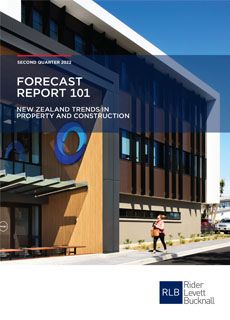According to the Rider Levett Bucknall (RLB) Forecast 101 report – New Zealand Trends in Property and Construction – construction has led the rebound in economic activity as lockdown restrictions were relaxed in early December 2021.
There was a particularly strong recovery in non-residential and infrastructure construction, but recent indicators point to some slowing in the pipeline of this type of construction work over the coming year.
Prepared by the New Zealand Institute of Economic Research (Inc.) (NZIER) exclusively for RLB, Forecast 101 confirmed construction sectors which bounced back in activity following the relaxation of lockdown restrictions include other construction (which is often taken as a proxy for infrastructure construction).
This area increased by 17.2 per cent in the December quarter following an 8.9 per cent decline in September, while non-residential construction increased 16.6 per cent following a 12.5 per cent contraction in the previous quarter.
Auckland leads the construction rebound
Residential construction, which has grown strongly over the past year as higher house prices encouraged new housing developments, increased by a more modest 6.2 per cent in the December quarter. Auckland led the way in the rebound in construction activity in December, reflecting the greater negative impact of the prolonged lockdown and social distancing restrictions in the region in the previous quarter.
RLB Director, Grant Watkins said “The spread of the more transmissible Omicron variant of COVID-19 in recent months has posed new challenges to the construction sector.”
Building firms struggling with worker shortages and supply chain disruptions
“Building sector firms are grappling with even more acute worker shortages and supply chain disruptions due to people staying at home because of COVID-19 infection or self-isolation. This has affected the ability of building sector firms to return to operating at full capacity,” he added.
According to Forecast 101, dwelling consent issuance points to a continued solid pipeline of residential construction work over the coming year, as high house prices encourage new housing supply to come onto the market. The annual number of dwelling consents issued for the year to February 2022 increased to a new record high of over 49,000.
Strong demand for housing drives growth in residential construction
Growth in residential construction demand has been driven by stronger demand for medium-density housing such as townhouses and flats. We expect this housing intensification will continue over the coming years, given the increased population density.
Grant continued, “Across the regions, demand remains particularly strong in Auckland, with annual dwelling consents issued for the year to February totalling over 20,500. The strong demand for residential construction in Auckland reflects the region’s relatively strong population growth in the years before the COVID-19 outbreak.”
He added, “Although non-residential construction activity rebounded strongly in the December 2021 quarter following the disruptions from the lockdown in the previous quarter, consent issuance points to variances in demand across the regions.”
Decline in demand for accommodation buildings
This growth in non-residential construction demand in Auckland has been broad-based across the sectors, with demand for healthcare facilities, office space and industrial buildings particularly strong. This is in contrast to the decline in demand for accommodation buildings in Auckland, which likely reflects the negative impact of international border restrictions on tourism activity.
In Canterbury, growth in non-residential demand primarily reflects stronger demand for education buildings. Demand for the construction of retail outlets in the region has also been solid over the past year.
Large amount of government infrastructure projects underway
According to RLB, despite some signs of easing in the pipeline of government construction, there is already a large amount of infrastructure construction projects underway. This includes $800 million for water infrastructure, $400 million allocated to transport and $1 billion to community facilities – most of which will likely ramp up over the next two years. This growth in infrastructure construction will be underpinned by the implementation of the 3 Waters reform programme.
The Australia New Zealand Infrastructure Pipeline (ANZIP) highlights the major projects underway. This includes the Auckland Airport Expansion, Auckland Hospitals Redevelopment, Auckland Light Rail, Canterbury Museum Redevelopment and Christchurch Hospital expansion2.
Elevated construction cost inflation expected
Grant concluded, “In terms of construction costs, non-residential construction cost inflation picked up in the December 2021 quarter, with the 2.2 per cent increase over the quarter bringing annual non-residential construction cost inflation to 7.7 per cent for the 2021 year.”
He added, “We forecast annual non-residential construction cost inflation will peak at 9.4 percent in March 2022. Beyond that, a relaxation of border restrictions later this year should alleviate labour shortages and drive a moderation in construction cost inflation from late 2022.”
The forecast peak in annual construction cost inflation is lower than that seen in the 2004 building boom, but we are expecting a more protracted period of elevated construction cost inflation given the high inflation environment more broadly.
Photo Credit: © Jason Mann
FURTHER INFORMATION:



